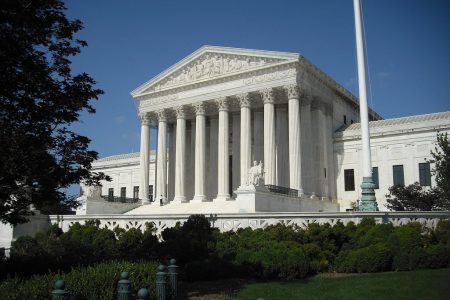Widgetized Section
Go to Admin » Appearance » Widgets » and move Gabfire Widget: Social into that MastheadOverlay zone
The Bright and Relentless Debate
The views expressed are those of the author and do not necessarily reflect the views of ASPA as an organization.
By Michelle M. Buehlmann
August 16, 2024

On June 28, 2024, the U.S. Supreme Court (the Court) issued the Loper Bright and Relentless decisions, overturning Chevron deference. Chevron deference outlined when the courts could defer to an agency’s reasonable interpretation of statutory language. The underlying reason behind the four decisions was the conceptualization of the relationships among the four key components of America’s constitutional system: Congress, the Presidency, the federal bureaucracy and the courts (CPBC). In their decision, the Court expressed three distinct views of these relationships, all of which marginalize Congress’s role in America’s constitutional system. Losing Chevron deference is a problem for public administrators caused by the fact that the Court ignored the “separate institutions sharing power” concept. Understanding the problem in these terms provides some hope for future improvement.
First, the holding examined CPBC relationships and articulated three points: (1)Congress can expressly delegate authority to the administrative agencies; (2)The courts have an obligation to police the limits of such delegation; and (3)The courts must monitor the agencies. The holding viewed Chevron deference as an absolute rule requiring judges to defer to administrative agencies when ambiguities arise. The justices supporting the holding contended that Chevron’s absolute deference was inconsistent with the courts’ duty to monitor agencies as specified in the Administrative Procedures Act, Section 706.
In his concurrence, Justice Thomas presented the second conceptualization of CPBC relationships: He imagined administrative agencies under strict executive branch control, only able to execute laws. Congress writes the laws and the courts interpret them. He posited three distinct branches with clearly distinguishable spheres of influence.
Justice Gorsuch’s concurrence was similar to Thomas’s in that he saw the Presidency as having absolute control over the bureaucracy. His description embraced Calabresi and Yoo’s (2008) definition of unitary executive theory, which imagined the federal bureaucracy operating “…in accordance with the President’s wishes.” Under Gorsuch’s argument, the bureaucracy would carry out the political whims of the Presidency even if those whims were contrary to the law. Therefore, Gorsuch argued overturning Chevron was necessary to protect American citizens from the political whims of the Presidency and presidential appointees, who might require federal agencies to disobey the law.
The dissent’s theory of the CPBC relationships was the same as the holding. They too ignored the ongoing role of Congress in managing these relationships. They disagreed with the holding because they viewed Chevron deference not as an absolute rule but as a presumption.
In overturning Chevron, the Court ignored Congress’s ongoing role in managing the bureaucracy, posited rigidly separate branches and relied on an extreme view of unitary executive theory. In all of this, the Court ignored the “separate institutions sharing power” concept.
Separate Institutions Sharing Power
Unlike unitary executive theory, which relies heavily on the Presidency’s implied powers found in the vesting clause of Article II, “separate institutions sharing power” relies on three explicit Congressional powers: to create agencies (Article I, section 8, clause 18); to control the purse (Article I, section 8, clause 7); and the Senate’s power to confirm Presidential appointees (Article II, section 2, clause 2). “Separate institutions sharing power” recognizes Congress’s ongoing role in managing the bureaucracy and identifies several tools Congress uses to carry out this function: oversight, authorization, reauthorization, appropriations and constituent casework. In addition, scholars such as Wood and Waterman have repeatedly demonstrated the empirical validity of “separate institutions sharing power.” Congress has control of the bureaucracy in reality, not just in theory.
The Court’s views of CPBC relationships are incongruous with “separate institutions sharing power” in three ways. First, the justices framed the debate as between authoritarianism (strong Presidential leadership) and autocracy (strong bureaucratic leadership). This is a false dichotomy that ignores Congress’s ongoing role in managing the bureaucracy. Second, the holding found Chevron deference interfered with the court’s duty to monitor the bureaucracy as specified in the Administrative Procedures Act. Ironically, the purpose of the act was to restore Congressional control over the bureaucracy following World War II, a fact the Court acknowledged in Morton Salt. The third incongruity in this decision is that it ignores James Madison’s critical line in Federalist Paper number 51: “In republican government the legislative authority, necessarily, predominates.”
On a pragmatic note, the holding indicates the courts must monitor agencies. However, the courts can only take a case that comes to them. When it comes to monitoring agencies, the courts are weak and slow. Congress can respond rapidly and decisively. For example, former President Trump was shot on July 13th. A Congressional hearing was held July 22nd. Secret Service Director Cheatle resigned July 23rd.
In this essay I argue that the Court overturned Chevron because they had three empirically incorrect understandings of the CPBC relationships. In all of them, the Court repeatedly marginalized Congress. Viewing public administrators’ Chevron problem in terms of the relationships among America’s four key constitutional system components provides hope for the future. Through education and persuasion, it is possible that some day the Court will see these relationships differently.
Author: Michelle M. Buehlmann received her MPA and PhD in political science from George Mason University. She served as a government relations professional for Congressman George W. Gekas; Senator James M. Jeffords; the American Association of Colleges for Teacher Education; the California State University; and the American Association of State Colleges and Universities. She has taught public administration and political science courses for George Mason University, American University and Northern Virginia Community College. Starting in August 2024, she will serve as clinical assistant professor of political science and public administration for the University of North Dakota, in Grand Forks. She can be reached at [email protected].


Follow Us!